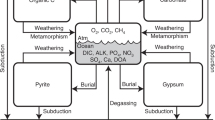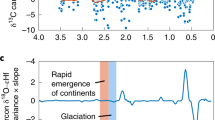Abstract
It has been hypothesized that, before widespread oxygenation about 2.45 billion years ago, the Earth’s atmosphere contained an organic haze similar to that on Titan. However, these theoretical predictions have not been substantiated by geological evidence. Here we use multiproxy geochemical analyses of sediments from the 2.65–2.5-billion-year-old Ghaap Group, in South Africa, to reconstruct ocean and atmospheric chemistry during this time. We find evidence for oxygen production in microbial mats and localized oxygenation of surface waters. Carbon and sulphur isotopes indicate that this oxygen production occurred under a reduced atmosphere that was periodically rich in methane, consistent with the prediction of a hydrocarbon haze. We use a photochemical model to corroborate our geochemical data. Our simulations predict transitions between two stable atmospheric states, one with organic haze and the other haze-free. The transitions are presumably governed by variations in the amount of biological methane production during the Archaean eon. We find that the isotopic signatures we observe are evident in other data sets from this period and conclude that methane was an important component of the atmosphere throughout the Archaean.
This is a preview of subscription content, access via your institution
Access options
Subscribe to this journal
Receive 12 print issues and online access
$259.00 per year
only $21.58 per issue
Buy this article
- Purchase on Springer Link
- Instant access to full article PDF
Prices may be subject to local taxes which are calculated during checkout



Similar content being viewed by others
References
Schroder, S., Lacassie, J. P. & Beukes, N. J. Stratigraphic and geochemical framework of the Aguoron drill cores, Transvaal Supergroup (Neoarchean-Paleoproterozoic, South Africa). South Afr. J. Geol. 109, 23–54 (2006).
Wille, M. et al. Evidence for a gradual rise of oxygen between 2.6 and 2.5 Ga from Mo isotopes and Re-PGE signatures in shales. Geochim. Cosmochim. Acta 71, 2417–2435 (2007).
Godfrey, L. V. & Falkowski, P. G. The cycling and redox state of nitrogen in the Archaean ocean. Nature Geosci. 2, 725–729 (2009).
Kendall, B. et al. Pervasive oxygenation along late Archean ocean margins. Nature Geosci. 3, 647–652 (2010).
Holland, H. D. The oxygenation of the atmosphere and oceans. Phil. Trans. R. Soc. B 361, 903–915 (2006).
Anbar, A. D. et al. A whiff of oxygen before the Great Oxidation Event? Science 317, 1903–1906 (2007).
Kaufman, A. J. et al. Late Archean biospheric oxygenation and atmospheric evolution. Science 317, 1900–1903 (2007).
Garvin, J., Buick, R., Anbar, A. D., Arnold, G. L. & Kaufman, A. J. Isotopic evidence for an aerobic nitrogen cycle in the latest Archean. Science 323, 1045–1048 (2009).
Reinhard, C. T., Raiswell, R., Scott, C., Anbar, A. D. & Lyons, T. W. A late Archean sulfidic sea stimulated by early oxidative weathering of the continents. Science 326, 713–716 (2009).
Altermann, W. & Nelson, D. R. Sedimentation rates, basin analysis and regional correlations of three Neoarchean and Paleoproterozoic sub-basins of the Kaapvaal Craton as inferred from precise U–Pb zircon ages from volcani-clastic sediments. Sedim. Geol. 120, 225–256 (1998).
Miyano, T. & Beukes, N. J. Phase relations of the stilpnomelane, ferriannite, and riebekite in very low-grade metamorphosed iron formations. Geol. Soc. South Afr. Trans. 87, 111–124 (1984).
Poulton, S. W. & Raiswell, R. The low-temperature geochemical cycle of iron: From continental fluxes to marine sediment deposition. Am. J. Sci. 302, 774–805 (2002).
Poulton, S. W. & Canfield, D. E. Ferruginous conditions: A dominant feature of the ocean through Earth’s history. Elements 7, 107–112 (2011).
Ono, S. et al. New insights into Archean sulfur cycle from mass-independent sulfur isotope records from the Hamersley Basin, Australia. Earth Planet. Sci. Lett. 213, 15–30 (2003).
Canfield, D. E. & Des Marais, D. J. Aerobic sulfate reduction in microbial mats. Science 251, 1471–1473 (1991).
Farquhar, J., Bao, H. M. & Thiemens, M. Atmospheric influence of Earth’s earliest sulfur cycle. Science 289, 756–758 (2000).
Pavlov, A. A. & Kasting, J. F. Mass-independent fractionation of sulfur isotopes in Archean sediments: Strong evidence for an anoxic Archean atmosphere. Astrobiology 2, 27–41 (2002).
Ono, S., Wing, B., Johnston, D., Farquhar, J. & Rumble, D. Mass-dependent fractionation of quadruple stable sulfur isotope system as a new tracer of sulfur biogeochemical cycles. Geochim. Cosmochim. Acta 70, 2238–2252 (2006).
Hinrichs, K-U. Microbial fixation of methane carbon at 2.7 Ga: Was an anaerobic mechanism possible?. Geochem. Geophys. Geosyst. 3, 1–10 (2002).
Thomazo, C., Ader, M., Farquhar, J. & Philippot, P. Methanotrophs regulated atmospheric sulfur isotope anomalies during the Mesoarchean (Tumbiana Formation, Western Australia). Earth Planet. Sci. Lett. 279, 65–75 (2009).
Hayes, J. M. in Early Life on Earth Vol. 84 (ed. Bengston, S.) 200–236 (Columbia Univ. Press, 1994).
Danielache, S. O., Eskebjerg, C., Johnson, M. S., Ueno, Y. & Yoshida, N. High-precision spectroscopy of 32S, 33S, and 34S sulfur dioxide: Ultraviolet absorption cross sections and isotope effects. J. Geophys. Res. 113, D17314 (2008).
Ueno, Y. et al. Geological sulfur isotopes indicated elevated OCS in the Archean atmsophere, solving faint young sun paradox. Proc. Natl Acad. Sci. USA 106, 14784–14789 (2009).
Domagal-Goldman, S. D., Kasting, J. F., Johnston, D. T. & Farquhar, J. Organic haze, glaciations and multiple sulfur isotopes in the Mid-Archean Era. Earth Planet. Sci. Lett. 269, 29–40 (2008).
Farquhar, J., Savarino, J., Airieau, S. & Thiemens, M. H. Observation of wavelength-sensitive mass-independent sulfur isotope effects during SO2 photolysis: Implications for the early atmosphere. J. Geophys. Res. 106, 32829–32839 (2001).
Farquhar, J. et al. Isotopic evidence for Mesoarchaean anoxia and changing atmospheric sulphur chemistry. Nature 449, 706–709 (2007).
Masterson, A. L., Farquhar, J. & Wing, B. A. Sulfur mass-independent fractionation patterns in the broadband UV photolysis of sulfur dioxide: Pressure and third body effects. Earth Planet. Sci. Lett. 306, 253–260 (2011).
Zmolek, P. et al. Large mass independent sulfur isotope fractionations during photopolymerization of (CS2)-C-12 and (CS2)-C-13. J. Phys. Chem. A 103, 2477–2480 (1999).
Domagal-Goldman, S. D. et al. Using biogenic sulfur gases as remotely detectable biosignatures on anoxic planets. Astrobiology 11, 419–441 (2011).
Zahnle, K., Claire, M. & Catling, D. The loss of mass-independent fractionation in sulfur due to a Palaeoproterozoic collapse of atmospheric methane. Geobiology 4, 271–283 (2006).
Halevy, I., Johnston, D. T. & Schrag, D. P. Explaining the structure of the Archean mass-independent sulfur isotope record. Science 329, 204–207 (2010).
Pavlov, A. A., Kasting, J. F. & Brown, L. L. UV-shielding of NH3 and O2 by organic hazes in the Archean atmosphere. J. Geophys. Res. 106, 1–23 (2001).
Wolf, E. T. & Toon, O. B. Fractal organic hazes provided an ultraviolet shield for early Earth. Science 328, 1266–1268 (2010).
Haqq-Misra, J. D., Domagal-Goldman, S. D., Kasting, P. J. & Kasting, J. F. A revised, hazy methane greenhouse for the Archean Earth. Astrobiology 8, 1127–1137 (2008).
Ono, S. H., Kaufman, A. J., Farquhar, J., Sumner, D. Y. & Beukes, N. J. Lithofacies control on multiple-sulfur isotope records and Neoarchean sulfur cycles. Precambrian Res. 169, 58–67 (2009).
Fischer, W. W. et al. Isotopic constraints on the Late Archean carbon cycle from the Transvaal Supergroup along the western margin of the Kaapvaal Craton, South Africa. Precamb. Res. 169, 15–27 (2009).
Acknowledgements
We thank J. Kirschvink, J. Grotzinger, A. Knoll and the Agouron Institute for organizing and financially supporting the Agouron drilling project. We also thank M. Thiemens for constructive comments on the manuscript. This study was financially supported by the NASA Exobiology Program and NASA Astrobiology Institute (A.L.Z. and J.F.) and a Natural Environment Research Council Fellowship (to A.L.Z.). M.W.C and S.D.D-G. would like to acknowledge support from the NASA Astrobiology Institute Virtual Planetary Laboratory and the NASA Postdoctoral Program.
Author information
Authors and Affiliations
Contributions
A.L.Z. led the study and carried out the sulphur-isotope analyses in the lab of J.F., M.W.C. and S.D.D-G. developed and ran the atmospheric models, S.W.P. collected the samples and carried out the Fe-speciation analyses. All authors contributed to the data interpretation and manuscript preparation.
Corresponding author
Ethics declarations
Competing interests
The authors declare no competing financial interests.
Supplementary information
Supplementary Information
Supplementary Information (PDF 1568 kb)
Rights and permissions
About this article
Cite this article
Zerkle, A., Claire, M., Domagal-Goldman, S. et al. A bistable organic-rich atmosphere on the Neoarchaean Earth. Nature Geosci 5, 359–363 (2012). https://doi.org/10.1038/ngeo1425
Received:
Accepted:
Published:
Issue Date:
DOI: https://doi.org/10.1038/ngeo1425
This article is cited by
-
Earth’s Great Oxidation Event facilitated by the rise of sedimentary phosphorus recycling
Nature Geoscience (2022)
-
Atmospheric oxygenation of the early earth and earth-like planets driven by competition between land and seafloor weathering
Earth, Planets and Space (2021)
-
A 200-million-year delay in permanent atmospheric oxygenation
Nature (2021)
-
Anomalous fractionation of mercury isotopes in the Late Archean atmosphere
Nature Communications (2020)
-
Is the Faint Young Sun Problem for Earth Solved?
Space Science Reviews (2020)



